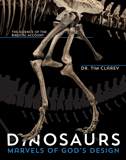
Dinosaur-Bird Confusion
It’s a bird . . . It’s a dinosaur . . . It’s a ???
News Source
- MSNBC: “‘Oldest Bird’ Knocked Off Its Perch”
For over a century evolutionists have intermittently speculated that birds evolved from dinosaurs. The current wave of dino-bird popularity continues as evolutionary paleontologists strain to see feathers in dinosaur fossils. Particularly popular members of the “feathered dinosaur” club often surface in China’s Liaoning Province. Xiaotingia zhengi—the latest so-called feathered fossil in Liaoning—is providing a creative way to draft the Archaeopteryx into the deinonychosaurian part of the dinosaur family.
No one can be certain where the Xiaotingia zhengi specimen came from “because it was purchased from a dealer, but all indications are that it comes from the Tiaojishan Formation, which dates from the Late Jurassic, some 155 million years ago,” according to Ohio University’s Dr. Lawrence Witmer.1 Paleontologist Xing Xu describes the fossil as “a new Archaeopteryx-like theropod.” Xu describes the fossil as having “faint feather impressions” and “some faint integumentary impressions,” adding, “Unfortunately, the feathers are too poorly preserved for details of their structure to be apparent.”2 The paper does not describe or picture any distinctive feather characteristics such as rachis and barbs.
Some evolutionists insist the Archaeopteryx is a transitional form because it had teeth, fingers on its wings, and a long tail.
Archaeopteryx is a fossilized extinct bird with exquisitely developed real feathers identical in preserved microscopic details to those of extant birds. Some evolutionists insist the Archaeopteryx is a transitional form because it had teeth, fingers on its wings, and a long tail. However, these features occur in other extinct or living birds. Evolutionary paleontologists assign it an age of about 150 million years. Though Archaeopteryx has long been the object of a tug-of-war between the dinosaur-camp and bird-camp, it is now commonly accepted as a bird. (Yet, many evolutionists3 claim that birds are dinosaurs anyway.)
Along comes the latest Chinese feathered dinosaur: Xiaotingia zhengi. Paleontologist Xing Xu’s team added Xiaotingia’s skeletal measurements (like long robust forelimbs) to “a computer database with measurements from 89 fossilized dinosaur and bird species, including Archaeopteryx.” Computer analysis had previously classified the Archaeopteryx “on the evolutionary line leading to modern-day birds.” When the Xiaotingia’s measurements were factored in, the computer decided the Archaeopteryx was a dinosaur after all.
But even the researchers admit, “Our phylogenetic hypothesis is only weakly supported by the available data.”4 They hasten to add that they would expect the distinctions to be fuzzy because they’re dealing with creatures similar to the common ancestor of birds and dinosaurs. In other words, the hypothetical common ancestor is assumed to have characteristics present in all its presumed descendants.
The ploy here is clear: if you can’t find a dinosaur with indisputably feathery feathers, recruit a bird by reclassifying it as a dinosaur. There are a host of problems in the evolutionary dinosaur-to-bird scenario. Respiratory systems, body aerodynamics, finger embryology, and the complexities of the feather compared to scales present irreducible complexities for the evolutionary paradigm. Evolutionists keep finding little bits of “dino-fuzz” on fossils, which other evolutionists believe are just fossilized collagen filaments. But if they can convince people that Archaeopteryx is a bona-fide dinosaur and not a bird, then they can stop hunting for a good example of a feathered dinosaur, having adopted one into the family.
How very convenient that the measurements of some bones suddenly tipped the classification scheme—which cannot reasonably get around the other dino-bird difficulties—into the very conclusion evolutionists have needed for decades. And as we have said before, even if a real feathered dinosaur were found, it would not be an evolving transitional form but only a demonstration that our human-designed classification schemes need revision.
Further Reading
- Did Dinosaurs Turn into Birds?
- The Evolution of Feathers: A Major Problem for Darwinism
- New Dinosaur-Bird Link?
- Yet Another New “Feathered” Dinosaur?
For More Information: Get Answers
Remember, if you see a news story that might merit some attention, let us know about it! (Note: if the story originates from the Associated Press, FOX News, MSNBC, the New York Times, or another major national media outlet, we will most likely have already heard about it.) And thanks to all of our readers who have submitted great news tips to us. If you didn’t catch all the latest News to Know, why not take a look to see what you’ve missed?
(Please note that links will take you directly to the source. Answers in Genesis is not responsible for content on the websites to which we refer. For more information, please see our Privacy Policy.)
Footnotes
- Lawrence M. Witmer, “An Icon Knocked from its Perch,” Nature 475 (July 28, 2011): 458–459, doi:10.1038/475458a.
- Xing Xu, Hailu You, Kai Du, and Fenglu Han, “An Archaeopteryx-Like Theropod from China and the Origin of Avialae,” Nature 475 (July 28, 2011: 466–467, doi:10.1038/nature10288.
- For example, evolutionist Phil Currie wrote, “In fact, because birds are the direct descendents of theropods, they are technically classified as theropod dinosaurs. Therefore, there are more than 10,000 species of theropods alive today.” Quoted in Michael Oard. “Did Birds Evolve from Dinosaurs?,” Journal of Creation 25, no. 2 (2011): 23.
- Xing Xu, Hailu You, Kai Du, and Fenglu Han, “An Archaeopteryx-Like Theropod from China and the Origin of Avialae.”
Recommended Resources

Answers in Genesis is an apologetics ministry, dedicated to helping Christians defend their faith and proclaim the good news of Jesus Christ.
- Customer Service 800.778.3390
- © 2024 Answers in Genesis




